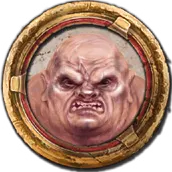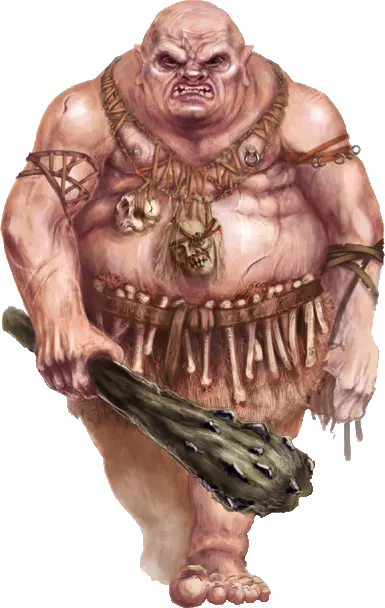“The children of the giant Ogeron still live among us today, and we can be happy that they are not as numerous as they once were. Their hunger cannot be sated, and all ogres prefer human flesh. Never forget the carnage that these powerful giants caused during the Battle of 1,000 Ogres, when a whole army had trouble routing them. Ogres are three times as strong as an adult human. When hungry, they swing clubs or throw rocks to kill what they want to eat.
It seems that Hesinde forgot about them when she was assigning intelligence. Ogres are as simple as they are strong, which is why it is easy to deceive them when you need to save your life.”
— Excerpt from an outdated version of the Bestiary of Belhanka
Ogres are the natural enemies of humans, as they hunger for their flesh. Their insatiable hunger is well known, and many wanderers or mushroom hunters have fallen prey to these muscular beasts. According to legend, they arose in their thousands from the remains of the ever-hungry giant Ogeron when it fell to Dere during the Giant Wars. Since that day, they are driven by Ogeron’s hunger for flesh. The people-eaters, as they are often called, stand more than 8 feet tall and are very corpulent. Their pale skin is hairless and shines with the rancid fat they use to cover their bodies. If you are lucky, this smell will alert you to their presence before you see them.
Ogres have some skill with crafts, and even though they know how to make fire, they often use their sharp, yellow teeth to rend and devour their prey raw. Ogres have the lowest intelligence of all such races in Aventuria, and their limited minds are slave to their instincts to feed and mate. When sated (a rare condition), an ogre can manage to hold a rather limited conversation (if it speaks your language, that is).
Distribution
Ogres can feel at home anywhere in Aventuria but choose to live mainly in ruins, abandoned structures, and caves. Sometimes they build simple leaf huts or dig short tunnels into the ground. Many ogre families roam the countryside throughout the year, and groups can be encountered almost anywhere, at any time. Cave ogres, which are human-sized, blind, and possess no exceptional senses, live only in the northern mountains.
Their closely-related but vegetarian cousins, known as moundlings, live in earthen caves in the upper Bodir and in the Orclands. So-called black ogres live on the Forest Islands and in the rain forests of the south. They are much more dexterous, smarter, and even somewhat civilized, and people fear them greatly because they can control their constant hunger long enough to create and follow plans.
Large populations of black ogres inhabit Uthuria, where they are said to have even built their own cities — nobody in Aventuria would have thought ogres capable of such feats. Ogres have never been seen in Myranor.
Way of Life
Ogres live in small family units comprised of three to six individuals. Males go out on raids that can last days, while females stay behind to guard the cave. Except for rare individuals with above average intelligence, Ogres speak only a basic, grunting language that borrows many words from Garethi or Oloarkh, the lesser orc language. There is evidence of a forgotten shamanistic culture that suggests ogres once possessed a higher level of civilization. Those few scholars who study the people-eaters even claim that ogres have their own oral tradition of myths and legends. Despite the constant hunger that drives many ogres, instances of cannibalism are exceedingly rare.
Ogres sometimes form partnerships of convenience with orcs or goblin gangs, though the poor goblins often wind up being eaten if the mutual raids don’t succeed. Orc shamans sometimes capture ogres to break their spirits with magic and beatings, and then arm and train these enslaved ogres to serve the orcs in war. Some shamans lend these battle-tested bodyguards to orc warriors as signs of favor, in return for those orcs’ loyalty.
Ogres normally hunt alone or in small groups, but in rare cases they form gangs, and hordes of flesh-hungry ogres have been known to threaten whole cities. Many people have faced the cruel fate of being devoured alive. In the year 1003 FB, a traitor named Galotta, the former court mage for the Imperial family, enslaved a large number of ogres (and other creatures) with dark magic to create an army. His forces marched towards the former capital of Tobrien Ysilia but were defeated at the Troll Gate (in what would later be known as the Battle of the 1,000 Ogres).
Ogre names often sound like little more than hungry, snarling noises. Some ogres (such as war ogres) receive names from the orcs they accompany into battle or from the humans whose villages they prey upon.
Female: Ahrkh, Arzach, Bone-Gnawer, Blood-Gargler, Gharraa, Lahuff, Meat-Cleaver, Orc-Death, Shlach, Zhuraar
Male: Arzuch, Barthak, Blood-Drinker, Bone-Drinker, Elf-Eater, Gorpp, Krog, Ullgump, Wehkhir, Yahrazz


